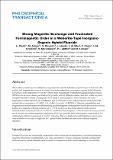Files in this item
Strong magnetic exchange and frustrated ferrimagnetic order in a weberite-type inorganic-organic hybrid fluoride
Item metadata
| dc.contributor.author | Clark, L | |
| dc.contributor.author | Pimenta, V | |
| dc.contributor.author | Lhoste, J | |
| dc.contributor.author | da Silva, I | |
| dc.contributor.author | Payen, C | |
| dc.contributor.author | Grenèche, J.-M. | |
| dc.contributor.author | Maisonneuve, V | |
| dc.contributor.author | Lightfoot, Philip | |
| dc.contributor.author | Leblanc, M | |
| dc.date.accessioned | 2019-05-27T09:30:02Z | |
| dc.date.available | 2019-05-27T09:30:02Z | |
| dc.date.issued | 2019-07 | |
| dc.identifier | 258479433 | |
| dc.identifier | 5c886173-2d77-410c-b2c2-01f29627b8b6 | |
| dc.identifier | 85066949551 | |
| dc.identifier | 000469033400005 | |
| dc.identifier.citation | Clark , L , Pimenta , V , Lhoste , J , da Silva , I , Payen , C , Grenèche , J-M , Maisonneuve , V , Lightfoot , P & Leblanc , M 2019 , ' Strong magnetic exchange and frustrated ferrimagnetic order in a weberite-type inorganic-organic hybrid fluoride ' , Philosophical Transactions of the Royal Society. A, Mathematical, Physical and Engineering Sciences , vol. 377 , no. 2149 . https://doi.org/10.1098/rsta.2018.0224 | en |
| dc.identifier.issn | 1364-503X | |
| dc.identifier.other | ORCID: /0000-0001-7048-3982/work/62668228 | |
| dc.identifier.uri | https://hdl.handle.net/10023/17763 | |
| dc.description | LC acknowledges the University of Liverpool for start-up funding and support. Work at the University of St Andrews was supported by a Leverhulme Research Project Grant. Access to beam time at the ISIS Neutron and Muon Facility was supported by the Science and Technology Facilities Council. The authors also gratefully acknowledge Delphine Toulemon, ITODYS, UMR7086 CNRS, Université Paris VII, for assistance with magnetisation measurements. | en |
| dc.description.abstract | We combine powder neutron diffraction, magnetometry and 57Fe Mössbauer spectrometry to determine the nuclear and magnetic structures of a strongly interacting weberite-type inorganic-organic hybrid fluoride, Fe2F5(Htaz). In this structure, Fe2+ and Fe3+ cations form magnetically frustrated hexagonal tungsten bronze (HTB) layers of corner sharing octahedra. Our powder neutron diffraction data reveal that, unlike its purely inorganic fluoride weberite counterparts which adopt a centrosymmetric Imma structure, the room- temperature nuclear structure of Fe2F5(Htaz) is best described by a non centrosymmetric Ima2 model with refined lattice parameters a = 9.1467(2) Å, b = 9.4641(2) Å and c = 7.4829(2) Å. Magnetic susceptibility and magnetisation measurements reveal that strong antiferromagnetic exchange interactions prevail in Fe2F5(Htaz) leading to a magnetic ordering transition at TN = 93 K. Analysis of low-temperature powder neutron diffraction data indicates that below TN, the Fe2+ sublattice is ferromagnetic, with a moment of 4.1(1) μB per Fe2+ at 2 K, but that an antiferromagnetic component of 0.6(3) μB cants the main ferromagnetic component of Fe3+, which aligns antiferromagnetically to the Fe2+ sublattice. The zero-field and in-field Mössbauer spectra give clear evidence of an excess of high-spin Fe3+ species within the structure and a non collinear magnetic structure. | |
| dc.format.extent | 1788513 | |
| dc.language.iso | eng | |
| dc.relation.ispartof | Philosophical Transactions of the Royal Society. A, Mathematical, Physical and Engineering Sciences | en |
| dc.subject | Neutron diffraction | en |
| dc.subject | Fluorides | en |
| dc.subject | 57Fe Mössbauer spectrometry | en |
| dc.subject | Coordination frameworks | en |
| dc.subject | QD Chemistry | en |
| dc.subject | DAS | en |
| dc.subject.lcc | QD | en |
| dc.title | Strong magnetic exchange and frustrated ferrimagnetic order in a weberite-type inorganic-organic hybrid fluoride | en |
| dc.type | Journal article | en |
| dc.contributor.institution | University of St Andrews. EaSTCHEM | en |
| dc.contributor.institution | University of St Andrews. School of Chemistry | en |
| dc.identifier.doi | https://doi.org/10.1098/rsta.2018.0224 | |
| dc.description.status | Peer reviewed | en |
| dc.date.embargoedUntil | 2019-05-26 |
This item appears in the following Collection(s)
Items in the St Andrews Research Repository are protected by copyright, with all rights reserved, unless otherwise indicated.

